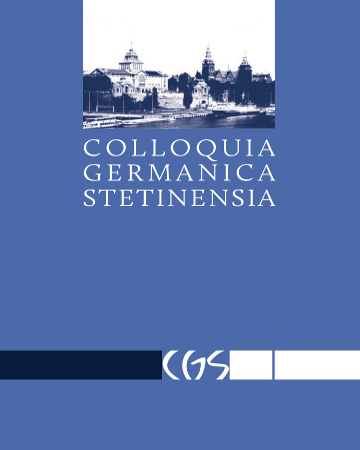







| Authors: |
Anna
Pilarski

Uniwersytet Szczeciński, Wydział Filologiczny, Instytut Filologii Germańskiej, Zakład Składni Porównawczej Języka Niemieckiego i Języka Jidysz |
| Keywords: | expletive subject Minimalist Program contrastive Yiddish-Polish-German grammar |
| Data publikacji całości: | 2018 |
| Page range: | 17 (97-113) |
| Downloads ?: | 494 |
| 1. | Bayer, Josef, Peter Suchsland. „Expletiva im Deutschen“. In: GGS (Generative Grammatik des Südens). Wien, Mai 1997. Zugriff: 12.12.2017. https://eclass.uoa.gr/modules/document/file.php/GS304/Artikel%20fuer%20Arbeiten/Bayer%20Expletiva%20GAGL-41-1997-02.pdf |
| 2. | Chomsky, Noam. „Minimalist Inquiries: The Framework“. In: Step by Step. Essays on Minimalist Syntax in Honor of Howard Lasnik, hrsg. v. Roger Martin, David Michaels, Juan Uriagereka, 89–156. Cambridge, Mass., London: The MIT Press., 2000. |
| 3. | Chomsky, Noam. Some concepts and consequences of the Theory of Government and Binding. Cambridge, Mass., London: The MIT Press., 1982. |
| 4. | Chomsky, Noam. The minimalist program. Cambridge, Mass., London: The MIT Press., 1995. |
| 5. | Diesing, Molly. „Verb movement and the subject position in Yiddish“. Natural Language and Linguistic Theory 8.1. (1990): 41–79. |
| 6. | Drosdowski, Günther (Hg.). Grammatik der deutschen Gegenwartssprache. Mannheim, Leipzig, Wien, Zürich: Bibliographisches Institut, 1959, 19662, 19844 = Duden, Bd. 4. |
| 7. | Eisenberg, Peter. Grundriss der deutschen Grammatik. Stuttgart: Metzler, 1986. |
| 8. | Engel, Ulrich. Deutsche Grammatik – Neubearbeitung. München: Iudicium Verlag, 2004, 20092. |
| 9. | Fanselow, Gisbert, Sascha Felix. Sprachtheorie 2: Rektions- und Bindungstheorie. Tübingen: Francke, 1993. |
| 10. | Fanselow, Gisbert. Konfigurationalität. Untersuchungen zur Universalgrammatik am Beispiel des Deutschen. Tübingen: Gunter Narr Verlag, 1987. |
| 11. | Fortmann Christian. Konstituentenbewegung in der DP-Struktur. Zur funktionalen Analyse der Nominalphrase im Deutschen. Tübingen: Max Niemeyer Verlag, 1996. |
| 12. | Geller, Ewa. „Jiddisch im Spannungsfeld zwischen Germanistik und Slawistik“. In: Convivium. Germanistisches Jahrbuch Polen. Polendiskurse, 2004: 171–197. |
| 13. | Grewendorf, Günther. Aspekte der deutschen Syntax. Eine Rektions-Bindungs-Analyse. Tübingen: Gunter Narr Verlag, 1988. |
| 14. | Grewendorf, Günther. Minimalistische Syntax. Tübingen, Basel: Francke, 2002. |
| 15. | Grewendorf, Günther. Sprache als Organ – Sprache als Lebensform. Frankfurt a. M.: Suhrkamp, 1995. |
| 16. | Groh, Arnold. Jiddisch Wort für Wort. Kauderwelsch, Bd. 110. Bielefeld: Reise Know-How Verlag, 1997. |
| 17. | Helbig, Gerhard. Deutsche Grammatik – Grundfragen und Abriss. München: Iudicium Verlag, 1991. |
| 18. | Järventausta, Marja. Das Subjekt im Deutschen und im Finnischen: seine Formen und semantischen Rollen. Frankfurt a. M.: Peter Lang, 1991. |
| 19. | Lockwood, William B. Lehrbuch der modernen jiddischen Sprache: mit ausgewählten Lesestücken. Hamburg: Helmut Buske Verlag, 1995. |
| 20. | Lötzsch, Ronald. Jiddisches Wörterbuch. Mannheim: Duden, 1992. |
| 21. | Mecner, Paweł. „Zu satzfinaler Subjektposition, Unakkusativität und C-Domäne im Jiddischen“. Linguistik online 80. 1/17 (2017): 71–94. Zugriff 10.01.2018. |
| 22. | Mohr, Sabine. „Eine Antwort auf die Frage, wo dem Jiddischen der Kopf steht“. In: GGS (Generative Grammatik des Südens), Universität Tübingen, 2005. |
| 23. | Pilarski, Anna. „Zur Operation Merge in den unpersönlichen się „sich“-Konstruktionen im Polnischen“. Colloquia Germanica Stetinensia 25 (2016): 299–320. DOI: 10.18276/cgs.2016.25-16. |
| 24. | Pilarski, Anna. Das Nullsubjekt im Polnischen. Dependenzielle Verbgrammatik und Generative Transformationsgrammatik im Modellvergleich. München: Iudicium Verlag, 2013. |
| 25. | Rizzi, Luigi. “Null object in Italian and the Theory of pro“. Linguistic Inquiry 17 (1986): 501–557. |
| 26. | Schallert, Oliver. Wortstellungstypologie des Jiddischen im Spannungsfeld zwischen den germanischen und den slawischen Sprachen. Manuskript, Philipps-Universität Marburg, 2007. |
| 27. | Schallert, Oliver. Zur Syntax der Ersatzinfinitivkonstruktion. Typologie und Variation. Tübingen: Stauffenburg Verlag, 2012. |
| 28. | Schmidt Claudia Maria. Satzstruktur und Verbbewegung. Eine minimalistische Analyse zur internen Syntax der IP (Inflection Phrase) im Deutschen. Tübingen: Max Niemeyer Verlag, 1995. |
| 29. | Stechow, Arnim, Wolfgang Sternefeld. Bausteine syntaktischen Wissens. Ein Lehrbuch der generativen Grammatik. Opladen: Westdeutscher Verlag, 1988. |
| 30. | Weissberg, Josef. Jiddisch. Eine Einführung. Bern, Frankfurt a. M., New York, Paris: Peter Lang, 1988. |